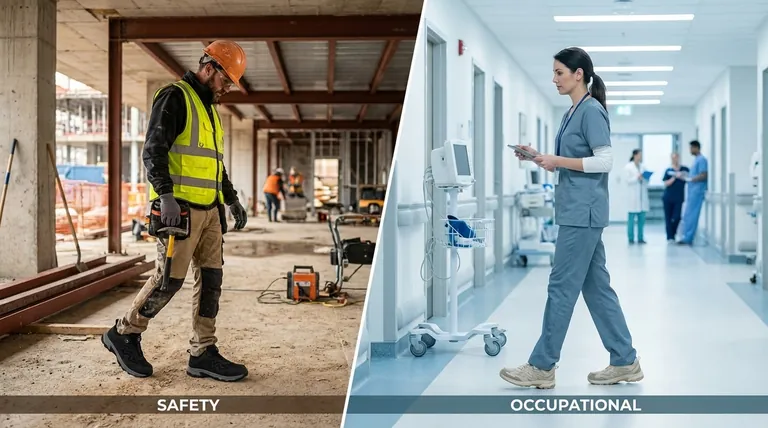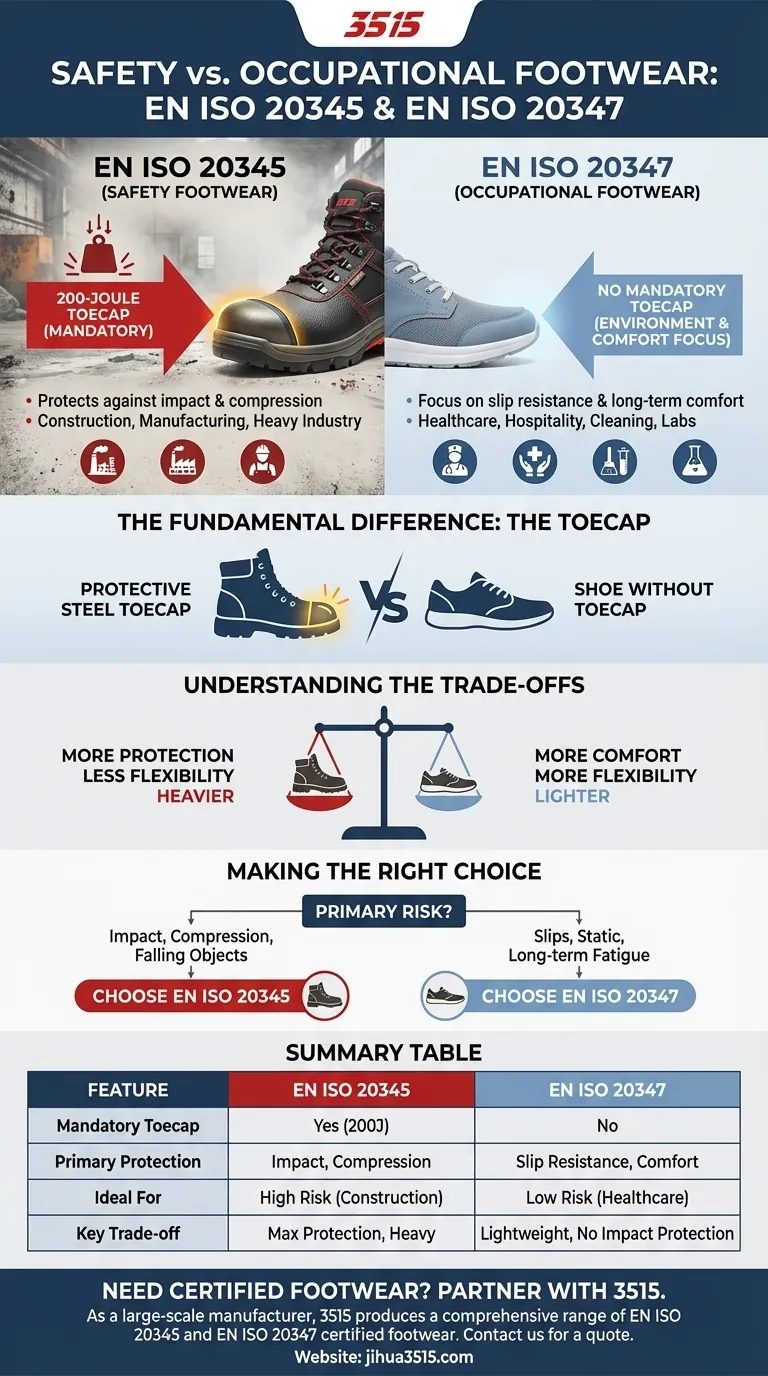The fundamental difference between EN ISO 20345 and EN ISO 20347 lies in one critical component: the protective toecap. EN ISO 20345 is the standard for Safety Footwear and mandates a toecap that withstands a 200-joule impact. In contrast, EN ISO 20347 is the standard for Occupational Footwear, which does not require a protective toecap and is designed for lower-risk environments.
The choice between these standards is not about which is "better," but about accurately matching the footwear's protective features to the specific hazards of your work environment. EN ISO 20345 protects against impact and compression, while EN ISO 20347 prioritizes slip resistance and comfort where impact risks are absent.

Decoding EN ISO 20345: The Standard for Safety Footwear
This standard defines the requirements for footwear designed to protect the user from significant physical harm in hazardous environments.
The Defining Feature: The 200-Joule Toecap
The non-negotiable requirement for any footwear certified to EN ISO 20345 is the presence of a protective toecap.
This toecap must withstand an impact energy of 200 joules, which is equivalent to a 20kg weight being dropped from a height of approximately one meter. It also provides compression protection.
Core Protective Requirements
Beyond the toecap, this standard includes basic requirements such as slip resistance, fuel oil resistance, and antistatic properties. Additional markings denote further protections like puncture resistance (P) or water resistance (WRU).
Typical Use Cases
This footwear is essential in environments where the risk of foot injury from falling objects or compression is high. This includes construction sites, manufacturing plants, warehouses, and any trade involving heavy materials or machinery.
Understanding EN ISO 20347: The Standard for Occupational Footwear
This standard applies to footwear intended for professional use where specific impact or compression risks have been ruled out by a risk assessment.
Protection Without the Toecap
The key distinction of EN ISO 20347 is the absence of a mandatory protective toecap. This footwear is not designed to protect against falling objects.
Focus on Environment and Comfort
Instead of impact resistance, this standard prioritizes features that mitigate other common workplace risks.
Key requirements often include an energy-absorbing heel for comfort during long periods of standing, robust slip resistance, and electrostatic properties for working near sensitive equipment.
Typical Use Cases
This footwear is ideal for professions where the primary hazards are slips, trips, and long-term fatigue. Common environments include healthcare, hospitality, cleaning services, and certain laboratory settings.
Understanding the Trade-offs
Choosing the wrong standard has significant consequences for both safety and comfort. It's crucial to understand what you gain and what you give up with each choice.
Protection vs. Weight and Flexibility
The steel or composite toecap required by EN ISO 20345 adds significant protection but also increases the footwear's weight and rigidity.
Footwear certified to EN ISO 20347 is generally much lighter and more flexible, providing greater comfort for individuals who are on their feet all day but are not exposed to impact hazards.
The Risk of Misapplication
Using occupational footwear in an environment that demands safety footwear is a critical error. EN ISO 20347 footwear offers no protection from a dropped tool or a rolling cart, leading to serious injury.
Conversely, wearing heavy safety footwear in a low-risk environment can cause unnecessary fatigue without providing any relevant safety benefit.
Making the Right Choice for Your Environment
Your decision must be based on a clear assessment of the risks present in your specific workplace.
- If your primary risk is impact or compression: You must choose footwear certified to EN ISO 20345 to protect against falling objects, heavy materials, or rolling equipment.
- If your primary risks are slips, static, and long-term fatigue: You should select footwear certified to EN ISO 20347, which is engineered for grip, comfort, and safety in low-impact settings.
Selecting the correct standard based on your workplace risk assessment is the most critical step in ensuring your personal safety at work.
Summary Table:
| Feature | EN ISO 20345 (Safety Footwear) | EN ISO 20347 (Occupational Footwear) |
|---|---|---|
| Mandatory Toecap | Yes (200-joule impact resistance) | No |
| Primary Protection | Impact, compression, and basic hazards | Slip resistance, comfort, static dissipation |
| Ideal For | Construction, manufacturing, heavy industry | Healthcare, hospitality, laboratories, low-risk areas |
| Key Trade-off | Maximum protection, but heavier and less flexible | Lightweight and flexible, but no impact protection |
Need Certified Safety or Occupational Footwear? Partner with 3515.
As a large-scale manufacturer, 3515 produces a comprehensive range of EN ISO 20345 and EN ISO 20347 certified footwear for distributors, brand owners, and bulk clients. Our production capabilities encompass all types of safety and occupational shoes and boots, ensuring you get the right protection, comfort, and compliance for your workforce.
Contact us today for a quote and let us help you equip your team with the right footwear.
Visual Guide

Related Products
- Advanced KPU Athletic Safety Shoe with Steel Toe Cap Anti-Slip Rotary Lacing System
- Premium Suede Sport Safety Shoes for Wholesale & Bulk Orders
- Premium Flame-Retardant Waterproof Safety Boots and Shoes
- Puncture-Resistant Velcro Safety Boots for Wholesale & Custom Manufacturing
- Premium Suede Metatarsal Guard Safety Boots Work Shoes
People Also Ask
- What protection do work boots offer against sharp objects? Your Guide to Puncture-Resistant Footwear
- What are the key safety features to consider when choosing work boots? Ensure Maximum Protection for Your Job
- What are the advantages and disadvantages of steel toe boots? A Guide to Maximum Protection vs. Comfort
- What safety boots are recommended for the construction industry? Ensure Maximum Protection on the Job Site
- Why are work boots essential for risk-bearing industries? Protect Your Workforce from Severe Hazards



















